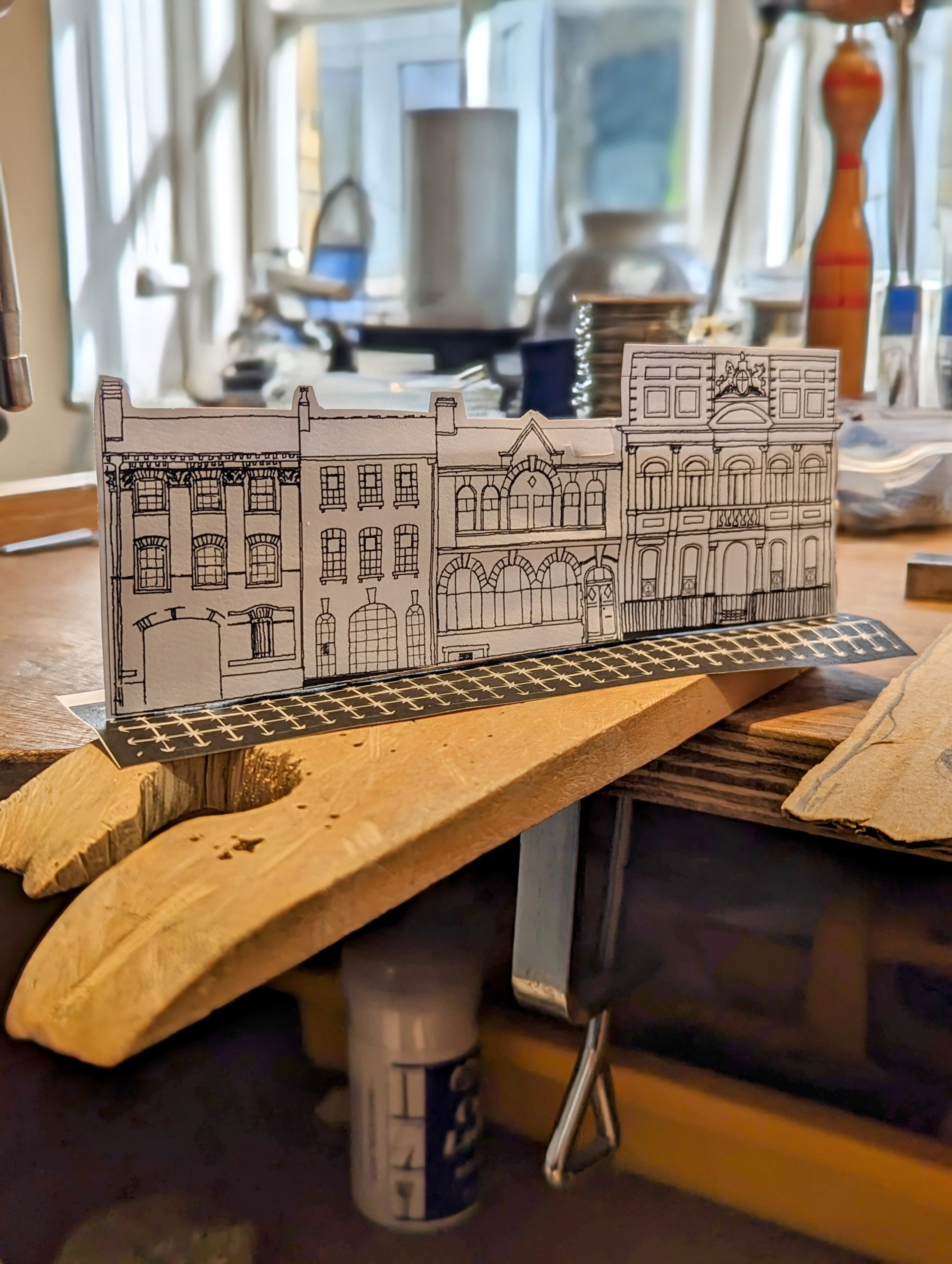silver sculptures
The brief:
To make art pieces celebrating Birmingham’s rich architectural and industrial past.
THE DESIGN
After a weekend research trip (I can definitely recommend Birmingham for a city break) I had a long list of potential buildings to explore further. From Blakesley Hall, one of Birminghams' oldest buildings and a fine example of a Tudor Hall, through fine examples of Victorian architecture such as the Birmingham Town Hall and Art Gallery to more contemporary buildings such as the Library of Birmingham.
Blakesley Hall, a Tudor Hall in Yardley
Sketches from Chamberlain Square, Birmingham Town Hall and Art Gallery
Also up for consideration from the Jewellery Quarter were these manufactories on Vittoria St.
Preliminary sketch of buildings in Vyse Street in the Jewellery Quarter. The building on the right made it into the final street.
I decided to focus on Aston Hall and the area famously known as The Jewellery Quarter.
My original pencil sketch of Aston Hall
aston hall
Aston Hall, a Grade 1 listed Jacobean house, was designed by John Thorpe and built by Sir Thomas Holte between 1618 and 1635.
Rich in history, it hosted King Charles I during the Civil War and was later besieged by Parliamentarians in 1643. The Hall’s great oak staircase still boasts a cannonball hole. My sculpture references the Hall’s Jacobean interior with an English oak mount.
Aston Hall stands on a rise overlooking Aston Villa’s Stadium. In the 19th century, the Hall’s grounds served as an early training space for the young team.
The silver balls on the front lawn are a gentle nod to the Hall’s Civil War past and its close connection to Aston Villa Football Club, whose stadium was built on what used to be Aston Hall Park land. The balls also serve a practical function, securing the lawn to the oak base.
The Jewellery Quarter
As a jeweller, I was drawn to this area of Birmingham to celebrate in silver. Important for its rich industrial history, the buildings display diverse architectural styles; Georgian and Victorian styles are dominant, but look closer, and you will see examples of other architectural styles, including Gothic, Italianate, Arts and Crafts, and Art Nouveau.
I selected some of these buildings to create a ‘street,’ which I mounted onto a Jeweller’s bench pin to represent the trade that is still so important in the area. I gave the street a pavement of pavers that would have originally covered the area.
The Jewellery Quarter art piece, in its purpose-made cherry box, is ready for its journey to Birmingham.
The buildings (Left to right)
33 Vittoria Street, a late 19th-century Grade II listed manufactory;
77-88 Vyse Street, home to the Smith and Pepper workshop (1899–1981) and is now the Birmingham Museum of Jewellery;
The Birmingham Assay Office, Newhall Street, 1877 until 2015. This was Birmingham’s first purpose-built Assay Office after Parliament granted the city the right to assay silver in 1773.
THE MAKE
I converted my hand-drawn sketches into black and white images so that I could create etching resists. After heat-transferring the resists onto my silver pieces, I etched them using a warm ferric nitrate solution. The length of time in the solution yields different results, helping to achieve particular finishes.
photo showing the layers of the building before soldering and piercing out the skyline.
For Aston Hall I went for quite a long etch time to achieve deep crunchy details which I think helps to age the building.
I etched the front entrance, side wings and central back on separate pieces of silver so that I could layer the building up to generate a sense of depth. Following the soldering process, lots of sanding and polishing added to the sense of wear and age.
The use of a silver ‘garden’ space in front of the elevation allows for reflections to add height and grandeur.
As I was treating The Jewellery Quarter Street as a linear plane, I chose to keep the etching process a little shorter than with Aston Hall. this resulted in a crisper etch to show off the details of the street scene.
Some of the few remaining staffordshire blue pavers which used to cover the streets of the Jewellery Quarter.
This photo shows an early version of the street scene stood on top of my own bench pin, which has seen better days!!
hallmarking
This is my street, ready to be sent to be hallmarked at Goldsmith’s in London. I wanted the hallmark to be in the position of the street sign on what used to be the Birmingham Assay Office. In this photo, you can see where I have placed a black mark (right-hand side) so that the assayers know where to make their marks.
The Jewellery Quarter about to be wrapped and sent to London for Hallmarking
I cold jointed the little sign to the face of the Museum of Jewellery having first etched the Anchor - which is Birmingham’s assay mark.
the price:
These pieces are currently on show in the Artisan Alchemy Gallery which is in the Jewellery Quarter of Birmingham.
















